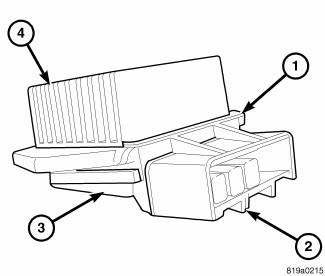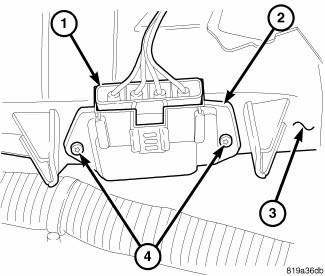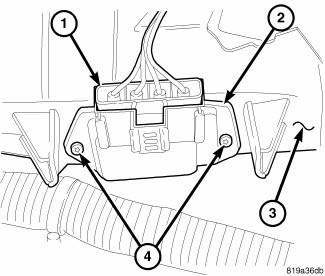Dodge Journey: Module, power, front blower motor
DESCRIPTION

Fig. 27: Blower Mtr Pwr Module
A blower motor power module is used on this model when equipped with the automatic temperature control (ATC) heating-A/C system. Models equipped with the manual temperature control (MTC) heating-A/C system use a blower motor resistor, instead of the blower motor power module.
The blower motor power module is mounted to the bottom of the HVAC housing, on the passenger side of the vehicle. The blower motor power module consists of a molded plastic mounting plate (1) with an integral connector receptacle (2). Concealed behind the mounting plate is the power module electronic circuitry (3) and a finned aluminum heat sink (4). The blower motor power module is accessed for service from under the instrument panel.
OPERATION
The blower motor power module is connected to the vehicle electrical system through a dedicated lead and connector of the instrument panel wire harness. A second lead and connector of the instrument panel wire harness is connected to the blower motor. The blower motor power module allows the microprocessor-based automatic temperature control(ATC) A/C-heater control to calculate and provide infinitely variable blower motor speeds based upon either manual blower switch input or the ATC programming using a pulse width modulated (PWM) circuit strategy.
The PWM voltage is applied to a comparator circuit which compares the PWM signal voltage to the blower motor feedback voltage. The resulting output drives the power module circuitry, which provides a linear output voltage to change or maintain the desired blower speed.
The blower motor power module is diagnosed using a scan tool. The blower motor power module cannot be adjusted or repaired must be replaced if inoperative or damaged.
REMOVAL
WARNING: Disable the airbag system before attempting any steering wheel, steering column or instrument panel component diagnosis or service. Disconnect and isolate the negative battery (ground) cable, then wait two minutes for the airbag system capacitor to discharge before performing further diagnosis or service. This is the only sure way to disable the airbag system. Failure to follow these instructions may result in accidental airbag deployment and possible serious or fatal injury.
WARNING: The heat sink for the blower motor power module may get very hot during normal operation. If the blower motor was turned on prior to servicing the blower motor power module, wait five minutes to allow the heat sink to cool before performing diagnosis or service. Failure to take this precaution may result in possible serious injury.

Fig. 28: Blower Motor Power Module
NOTE: LHD model shown. RHD model similar.
1. Disconnect and isolate the negative battery cable.
2. Disconnect the wire harness connector (1) from the blower motor power module (2) located at the bottom of the HVAC housing (3) on the passenger side of the vehicle.
3. Remove the two screws (4) that secure the blower motor power module to the HVAC housing and remove the power module.
INSTALLATION

Fig. 29: Blower Motor Power Module
NOTE: LHD model shown. RHD model similar.
1. Position the blower motor power module (2) into the bottom of the HVAC housing (3).
2. Install the two screws (4) that secure the blower motor power module to the HVAC housing. Tighten the screws to 1.2 N.m (10 in. lbs.).
3. Connect the wire harness connector (1) to the blower motor power module.
4. Reconnect the negative battery cable.
 Removal, Installation
Removal, Installation
REMOVAL
WARNING: Disable the airbag system before attempting any steering
wheel, steering
column, or instrument panel component diagnosis or service. Disconnect
and isolate the negat ...
 Resistor, blower motor, front
Resistor, blower motor, front
DESCRIPTION
Fig. 30: Blower Motor Resistor - Description
A blower motor resistor is used on vehicles equipped with the manual
temperature control (MTC) heating-A/C
system. Vehicles equipped wit ...
See also:
Description
Fig. 1: Front Suspension Components
This vehicle has a gas pressurized MacPherson strut type front suspension
design.
Each side of the front suspension consists of these major components:
...
Description, Operation
DESCRIPTION
Fig. 87: PRIMARY AND SECONDARY BRAKE TUBES
All master cylinders (2) are a two-outlet design and the brake tubes from
these primary and secondary outlet
ports lead directly to the In ...
Transducer, A/C pressure
DESCRIPTION
Fig. 44: A/C Pressure Transducer
- A/C PRESSURE TRANSDUCER
The A/C pressure transducer (1) is a switch that is installed on a fitting
located on the A/C liquid line at the righ ...
